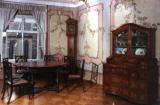2024. May 1. Wednesday
Soproni Museum - Fabricius House - Sopron

|
Address: 9400, Sopron Fő tér 6.
Phone number: (99) 311-327
E-mail: sopronimuzeum@gmail.com
Opening hours: 01.10-31.03.: Tue-Sun 10-14
01.04-30.09.: Tue-Sun 10-18 |
Underneath the Fabricius house archeologists found the remainders of a Roman bath. In the 14th century two houses stood on the site. The rear building – which had two floors as early as it was built - gives home to the exhibitions of the museum.
There is a loggia from the 17th century and a gothic and baroque cellar under the rear part of the house, which is also arranged into an exhibition room. Cellars in Sopron were not built in the vineyards but underneath the houses, probably because the well-being of the town was dependent on the wine which was thus protected.
The owners of the building were always rich merchants or honourable citizens.
Nominator of the house, Endre Fabricius town mayer bought the house in 1806. He was a friend to Sándor Petőfi, who was a soldier in Sopron. Sándor Petőfi escaped from the barrack and put on acivil clothing here, so that he could go and listen to the piano concert of Ferenc Liszt.
The building gives home to several exhibitions. There are Roman grave stones, altar stones and statues in the gothic and baroque cellar. The stone collection contains relics originated from Scarbantia - the Roman equivalent of Sopron. The medieval cellar serving as the exhibition space covers the rambles of Roman buildings.
There is a loggia from the 17th century and a gothic and baroque cellar under the rear part of the house, which is also arranged into an exhibition room. Cellars in Sopron were not built in the vineyards but underneath the houses, probably because the well-being of the town was dependent on the wine which was thus protected.
The owners of the building were always rich merchants or honourable citizens.
Nominator of the house, Endre Fabricius town mayer bought the house in 1806. He was a friend to Sándor Petőfi, who was a soldier in Sopron. Sándor Petőfi escaped from the barrack and put on acivil clothing here, so that he could go and listen to the piano concert of Ferenc Liszt.
The building gives home to several exhibitions. There are Roman grave stones, altar stones and statues in the gothic and baroque cellar. The stone collection contains relics originated from Scarbantia - the Roman equivalent of Sopron. The medieval cellar serving as the exhibition space covers the rambles of Roman buildings.
